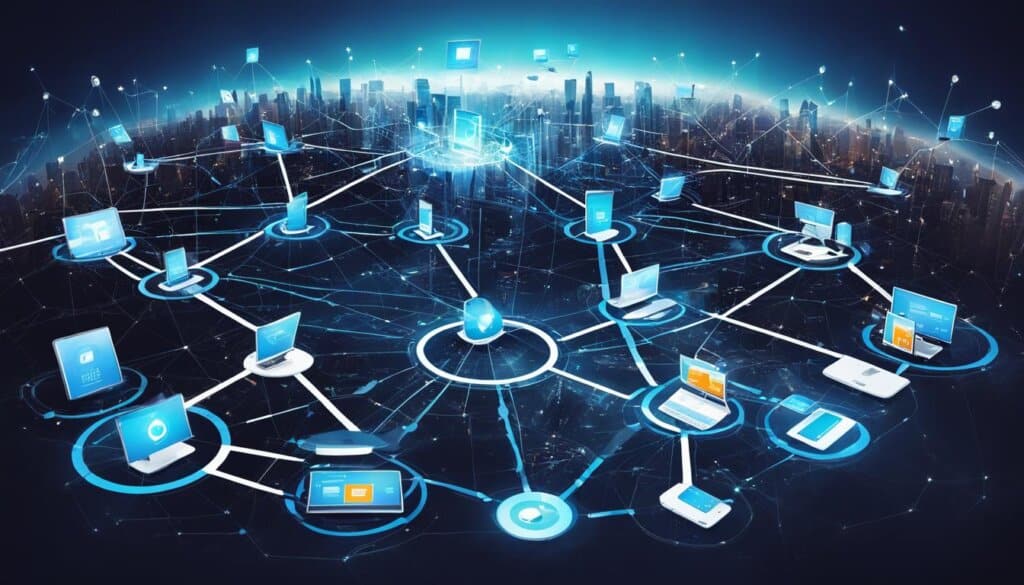Table of Contents
Welcome to our article on IoT devices, also known as Internet of Things devices. In this section, we will provide you with a brief introduction to IoT devices and what they entail. So, let’s dive in and explore the world of IoT devices.
The Internet of Things, or IoT, is a vast network of interconnected devices that exchange data with each other and the cloud. These devices are equipped with sensors, software, and other technologies. They can be physical machines, digital objects, or even consumer products. Their primary function is to collect data from their surroundings and communicate that data without human interaction.
IoT devices have revolutionized various industries, including manufacturing, transportation, healthcare, and retail. They enhance efficiency, improve customer service, aid in decision-making, and ultimately add value to businesses. The possibilities with IoT devices are endless, and more industries are realizing their potential.
Now that we have a basic understanding of what IoT devices are, let’s move on to the next section where we will delve deeper into how these devices work and their underlying technology.
How IoT Devices Work
IoT devices are powered by embedded systems, which include processors, sensors, and communication hardware. These devices are designed to collect, send, and act on data, enabling seamless connectivity within the IoT ecosystem.
One of the key components of IoT devices is the IoT gateway. This gateway serves as the bridge between the devices and the cloud. It collects sensor data from the devices and can analyze the data locally before transferring it to the cloud for further processing and storage.
IoT devices have the ability to communicate with each other without human intervention. They can share data and collaborate to perform tasks, creating an interconnected network of devices that work together to achieve a common goal.
The connectivity and communication protocols used by IoT devices vary depending on the specific application. Some common protocols include Wi-Fi, Bluetooth, Zigbee, and Z-Wave. These protocols enable seamless data transfer and communication between devices, ensuring efficient and reliable operation within the IoT ecosystem.
Furthermore, IoT devices can leverage artificial intelligence and machine learning technologies to enhance their data collection processes. These technologies enable devices to learn and adapt based on the data they collect, improving their capabilities over time.
“IoT devices use embedded systems, such as processors and sensors, to collect and send data. They can communicate with each other, utilizing connectivity protocols, and even employ machine learning.
To summarize, IoT devices work by utilizing embedded systems to collect, send, and act on data. They rely on IoT gateways for local data analysis and communication with the cloud. The connectivity protocols and machine learning capabilities enhance their functionality, making them an integral part of the IoT ecosystem.
| Key Points |
|---|
| IoT devices use embedded systems for data collection and communication |
| IoT gateways analyze data locally before sending it to the cloud |
| Connectivity protocols enable seamless data transfer between devices |
| IoT devices can leverage machine learning technologies to enhance their capabilities |
Benefits and Applications of IoT Devices
The Internet of Things (IoT) has revolutionized the way we live and work, offering a plethora of benefits and applications that span across various industries. From improving daily activities to providing real-time data, IoT devices have become indispensable in today’s digital landscape.
For businesses, the benefits of IoT are abundant. By harnessing the power of IoT devices, companies can monitor their processes in real time, ensuring efficiency and optimizing productivity. This real-time monitoring allows for immediate intervention and preventive maintenance, minimizing downtime and saving both time and money.
Additionally, IoT devices provide valuable insights into customer behavior, enabling businesses to enhance the overall customer experience. By leveraging data from IoT devices, companies can personalize their products and services, tailoring them to meet customer preferences and demands. This not only boosts customer satisfaction and loyalty but also allows businesses to generate more revenue.
The applications of IoT devices can be found in various industries, making a significant impact on how they operate. In the manufacturing sector, IoT devices can be used to monitor machines and optimize production processes. From predictive maintenance to real-time quality control, IoT devices streamline operations, reduce costs, and improve overall efficiency.
In the healthcare industry, IoT devices play a vital role in patient monitoring and care. These devices can track patient health metrics, such as heart rate, blood pressure, and glucose levels, providing healthcare professionals with real-time data. This data enables timely interventions and improves the quality of care, ultimately saving lives.
Retail is another industry that greatly benefits from the integration of IoT devices. These devices can manage inventory in real time, ensuring accurate stock levels and reducing the risk of overstocking or out-of-stock situations. Additionally, IoT devices can enhance the customer experience by providing personalized recommendations and improving overall store operations.
Benefits of IoT Devices:
- Real-time monitoring and optimization
- Improved customer experience
- Cost and time savings
- Enhanced productivity
- Increased revenue
IoT Applications in Different Industries:
| Industry | IoT Applications |
|---|---|
| Manufacturing | Machine monitoring and optimization |
| Healthcare | Patient monitoring and care |
| Retail | Inventory management and customer experience enhancement |
IoT is revolutionizing every industry it touches, continuously advancing as more businesses recognize its potential. The ability to connect and exchange data across devices and the cloud opens up endless possibilities, enabling smarter living and working environments.

Security and Challenges of IoT Devices
IoT device management plays a crucial role in integrating, monitoring, and remotely managing IoT devices. With the increasing number of IoT devices, it becomes essential to have effective management solutions in place. Through efficient IoT device management, businesses can streamline operations and ensure optimal performance of their interconnected devices.
However, along with the numerous benefits that IoT devices bring, there are also security risks that need to be addressed. The interconnected nature of IoT devices expands the attack surface, making them vulnerable to cyber threats. Unsecured hardware, poor asset management, and unencrypted data transmissions further amplify these risks, potentially leading to data breaches and compromise of sensitive information.
To mitigate these risks, standardized protocols and services are available for device management and security. These protocols enable secure device connectivity and facilitate secure data transfer between IoT devices and the cloud. Popular connectivity and networking protocols used in IoT environments include Constrained Application Protocol (CoAP), Datagram Transport Layer Security (DTLS), Message Queuing Telemetry Transport (MQTT), and Advanced Message Queuing Protocol (AMQP).
To safeguard IoT devices and networks, various security measures need to be implemented. This includes authentication mechanisms to verify the identity of devices and users, encryption techniques to protect data confidentiality, strong passwords to prevent unauthorized access, and network segmentation to isolate critical IoT components from potential threats.
FAQ
What are IoT devices?
IoT devices are a network of interrelated devices that connect and exchange data with each other and the cloud. They are embedded with technology such as sensors and software and can include mechanical and digital machines and consumer objects.
How do IoT devices work?
IoT devices collect, send, and act on data acquired from their environments. They use embedded systems like processors, sensors, and communication hardware to collect, send, and act on data. These devices share sensor data through an IoT gateway, which can analyze the data locally before sending it to the cloud.
What are the benefits and applications of IoT devices?
IoT devices have various benefits and applications in industries such as manufacturing, transportation, healthcare, and retail. They can monitor machines and optimize production in manufacturing, track patient health and improve care in healthcare, manage inventory and enhance the customer experience in retail, and much more. IoT devices improve efficiency, customer service, decision-making, and business value in various industries.
What are the security risks of IoT devices?
Security risks of IoT devices include increased attack surfaces, unsecured hardware, poor asset management, and unencrypted data transmissions. To safeguard IoT devices and networks, measures like authentication, encryption, strong passwords, and network segmentation should be implemented. Standardized protocols and services are available for device management and security.







